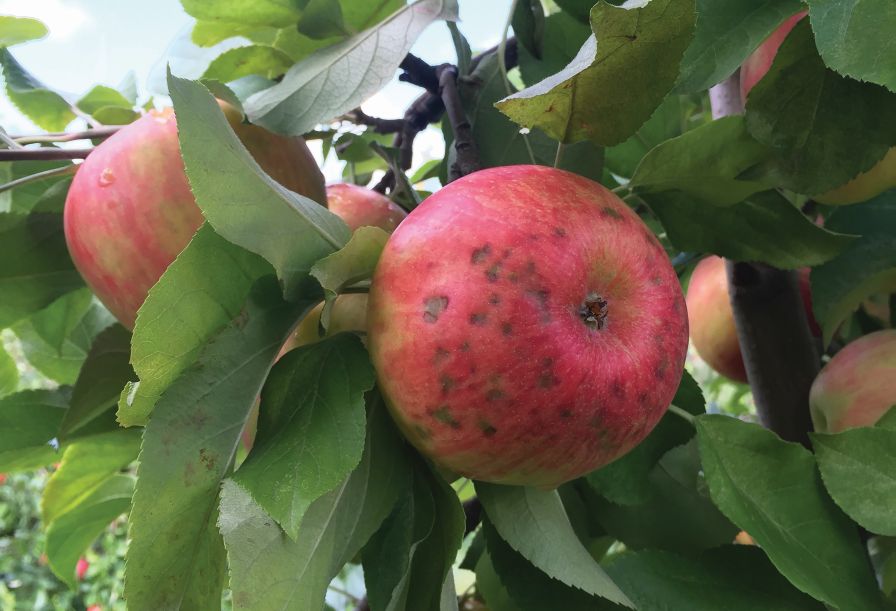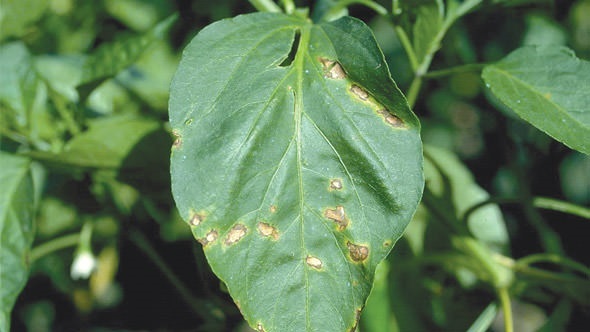Ease Bitter Pit by Boosting Calcium
Anyone who grows ‘Honeycrisp’ understands how difficult preventing bitter pit can be. Promising research from Cornell University hopes to understand the role that transpiration has with calcium uptake and calcium disorders, such as bitter pit.

Untreated ‘Honeycrisp’ apples exhibiting bitter pit. (Photo: Poliana Francescatto)
“Many environmental conditions, crop status, and mineral factors, such as drought and salinity, relative humidity, high light and temperatures, light crops and large fruit, and mineral imbalance conditions (excessive soil levels of nitrogen and potassium) have been shown to affect whole plant calcium uptake and translocation to the fruit, and consequently fruit susceptibility to calcium deficiency disorders,” says Poliana Francescatto, Research Associate in the Department of Horticulture at Cornell University.
Francescatto says previous studies have shown that the tissues of fruit with calcium-related disorders show lower rates of transpiration when compared with other parts of the plant, and calcium transportation in plants is driven through transpirational water flow. What’s important to understand is calcium uptake is through the roots into the fruit and vegetative tissue.
“Young fruit tissues have higher water potentials and lower distribution of stomata, 30 times less than the number of stomata present in the apple leaves,” she says. “Therefore, most of the xylemic water and calcium flow towards the leaves and away from fruit, which explain the high levels of calcium concentration in leaf tissue compared with fruit tissue.”
Abscisic Acid Is Key
The idea to incorporate abscisic acid (ABA), a plant growth regulator which is known to reduce leaf transpiration, came from previous research at the University of California, Davis, which applied ABA to tomatoes to help improve calcium uptake and prevent blossom end rot.
Since bitter pit is a calcium disorder, Francescatto thought the research might have a fit in apples.

‘Honeycrisp’ trees treated with abscisic acid to prevent leaf transpiration. In Francescatto’s studies, trees treated with abscisic acid show less than 5% incidence of bitter pit.(Photo: Poliana Francescatto)
“My first thought was that the hypothesis used for tomato, in which ABA -related plants would reduce leaf transpiration without significantly changing fruit transpiration, could successfully be applied for apples,” she said. “Increasing ABA levels in the leaves may favor xylemic water and calcium uptake into the low-transpiring fruit tissue, and help reduce calcium disorders.”
Francescatto’ s first trial was with ‘Honeycrisp’ and ‘Melrose’ where trees were sprayed with ABA throughout the season as part of her Ph.D. studies at Ohio State University with Dr. Jozsef Racsko in 2012. She said the results were promising. Once at Cornell University, she’s conducted several studies with ABA and ‘Honeycrisp’ at the New York State Agricultural Experiment Station in Geneva, NY, and had less than 5% bitter pit in ABA-treated apples.
“Results to date have exceeded expectation and been quite consistent. Foliar applications of ABA significantly reduced bitter pit incidence of apples, in some occasions by more than 50% compared to the untreated control trees, at both harvest and after storage. In general, calcium uptake into the fruit tissue tends to increase with ABA foliar spray treatments,” she said.
Side Effects
Francescatto says there has also been some leaf yellowing in warm years with ABA at high rates, but says the implications are minimal. She also says she has not seen any negative impacts on fruit production, size, or quality, but adds that ABA can cause thinning if it is applied at high rates early in the season.
“Even knowing that the critical time for best calcium uptake is at early stages of fruit development, we have only started spraying ABA a couple of weeks after petal fall trying to avoid the thinning window,” she says. “Further investigations on using lower doses of ABA are under investigation.”

Poliana Francescatto of Cornell University, with the help of Lailiang Cheng, illustrates the difference in ‘Honeycrisp’ when s-abscisic acid is applied to prevent transpiration with an untreated branch on the left and a treated branch on the right at the Cornell Fruit School in 2016. (Photo credit: Christina Herrick)
Francescatto also says there have been speculations on the impact of ABA and photosynthesis; however, she has not seen any impact on tree growth and the trees applied with ABA perform the same as the controls in her study.
Future Studies
Francescatto will continue to study the impact of ABA on thinning. If there is a link between ABA applications and fruit thinning, this may have promising implications for organic growers, or perhaps help with biennial bearing.
“We are continually evaluating if ABA could cause any possible undesirable effect,” she says. “Our next efforts will be focused on testing lower rates of ABA and reducing the number of ABA applications to develop a program that is cost effective for the grower.”
ABA is commercially available and labeled for use on grapes and pears in Washington and Oregon. ProTone (S-Abscisic Acid, Valent BioSciences) has been used to enhance color development in table grapes. It is being evaluated for thinning in apples and pears, but has a supplemental label for thinning in pears in Washington and Oregon.
“While much more research is needed before providing a ‘magic recipe’ for growers, our results have so far showed that ABA might be a promising tool for bitter pit control in apples, especially for the most profitable variety, ‘Moneycrisp,” she says.










